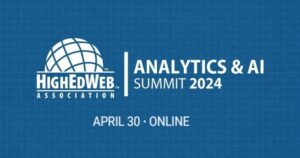In the rapidly evolving landscape of higher education marketing, professionals are constantly seeking ways to enhance efficiency, improve engagement and streamline content strategies.

At the HighEdWeb 2024 Analytics & AI Summit, marketing professionals gathered online to explore these very topics. This blog post will highlight key subjects covered at the summit while offering practical applications for leveraging AI and analytics in your daily routines and large projects.
Here are essential insights and tips on how to harness these powerful tools to enhance your institution’s marketing efforts and achieve your goals.
Session recordings + professional development library
Paid membership provides unlimited on-demand access to session recordings. The Professional Development Library includes all recordings from the 2024 Analytics and AI Summit and other conferences.
Enhance content creation and distribution
There’s a lot of buzz about how generative AI tools can streamline your daily routine and boost productivity.
AI tools like ChatGPT can draft content, suggest improvements and provide data-driven insights, helping marketing teams create high-quality content faster. However, maintaining a human-centered approach with reviews and revisions is crucial. Optimizing content for Google’s Search Generative Experience (SGE) by structuring it around specific questions can improve search engine visibility. Using tools like Google Search Console to identify common questions can enhance your content strategy, boosting engagement and reach.
Tip 1: Use generative AI tools
AI tools like ChatGPT can expedite the content creation process by generating initial drafts, suggesting improvements, and providing data-driven insights. This allows marketing teams to produce high-quality content faster, ensuring it resonates with their target audience.
Practical Application: Draft blog posts, social media content, and web page copy using AI tools. Follow up with human editing to align with the institution’s tone and messaging.
Tip 2: Optimize content for SEO
Google’s Search Generative Experience (SGE) emphasizes question-based search behavior. Structuring content around specific questions can significantly improve search engine visibility.
Practical Application: Use tools like Google Search Console to identify commonly asked questions related to your institution and integrate these into your content strategy.
Improve data-driven decision making
At the recent Analytics and AI Summit, colleagues delved into strategies to enhance data-driven decision-making, emphasizing practical tools and the correct setup of analytics accounts to maximize their effectiveness.
Proper implementation through tools like Google Tag Manager ensures accurate data collection, enabling custom reports that monitor essential metrics. Additionally, leveraging tools such as Looker Data Studio to visualize complex data facilitates informed decisions by creating intuitive dashboards that track engagement and performance metrics effectively.
Tip 3: Transition to Google Analytics 4 (GA4)
GA4 offers advanced features for tracking and analyzing user behavior. Proper implementation can provide deeper insights into how users interact with your digital properties.
Practical Application: Set up GA4 using Google Tag Manager for accurate data collection and create custom reports to monitor key metrics.
Tip 4: Leverage advanced analytics tools
Tools like Looker Data Studio can visualize complex data, making it easier to share insights and inform strategic decisions.
Practical Application: Create dashboards to track engagement and performance metrics, ensuring data is actionable and easy to understand.
Foster engagement with AI-powered tools
In today’s digital landscape, fostering engagement with AI-powered tools is essential for institutions. By implementing chatbots and personalizing user interactions, colleges can significantly enhance user experiences and boost engagement with prospective students.
These AI-driven strategies not only streamline routine inquiries but also create tailored content and marketing campaigns, leading to higher conversion rates.
Tip 5: Implement chatbots
Chatbots can enhance user experience by providing instant answers to FAQs and personalized assistance, improving engagement with prospective students.
Practical Application: Deploy chatbots on your website to handle routine inquiries, freeing up staff to focus on more complex tasks.
Tip 6: Personalize user interactions
Using AI to tailor content and interactions based on user behavior and preferences can significantly enhance engagement and conversion rates.
Practical Application: Analyze user data to create personalized content recommendations and targeted marketing campaigns. You can even leverage AI to create user personas that will help guide a personalized experience for your audience.
Foster a collaborative approach
Embracing a collaborative approach is essential for creating dynamic digital marketing strategies.
By fostering cross-team collaboration and aligning goals, marketing, admissions and web teams can work together seamlessly. Plus, focusing on a people-centric approach ensures that the needs and expectations of all stakeholders are met, resulting in more successful and engaging digital initiatives.
Regularly sharing insights and gathering feedback from students, faculty and staff helps ensure everyone is united and working toward common objectives.
Tip 7: Promote cross-team collaboration
Aligning goals and fostering communication between marketing, admissions and web teams can lead to more effective and cohesive strategies.
Practical Application: Regularly share insights and feedback across teams to ensure everyone is working towards common objectives.
Tip 8: Develop a people-centric approach
Emphasize the importance of understanding and addressing the needs of all stakeholders involved in the digital marketing process.
Practical Application: Engage with students, faculty and staff to gather feedback and ensure that digital strategies align with their expectations and needs.
Advanced strategies and ethical considerations
Creating ethical AI workflows ensures the responsible and transparent use of AI tools, with proper training and regular audits to maintain compliance with institutional standards.
Staying ahead through continuous learning is vital in the ever-evolving field of AI and analytics. Engaging in conferences, webinars and training sessions helps keep knowledge and skills up to date, ensuring a competitive edge in the digital landscape. After all, staying ahead in AI and analytics is all about keeping those skills polished and ready for whatever comes next!
Tip 9: Create ethical AI workflows
Proper training and ethical considerations are crucial for effective AI deployment. Ensure AI tools are used responsibly and transparently.
Practical Application: Develop workflows that include guidelines for ethical AI use and regular audits to ensure compliance with institutional standards.
Tip 10: Stay ahead with continuous learning
The field of AI and analytics is constantly evolving. Stay updated with the latest trends and best practices to maintain a competitive edge.
Practical Application: Participate in conferences, webinars, and training sessions to continuously enhance your knowledge and skills.
By integrating these strategies, we can harness the power of AI and analytics to create efficiencies, enhance engagement, and make data-driven decisions that drive success in their institutions.
What are some other tips or practical applications you are exploring at your institution? Share how you’re using AI in your higher education marketing work with Link Journal for a future article.

About the author
As Director of Client Engagement at GMB, Allison Lanier helps clients achieve their enrollment goals through effective and rewarding onboarding experiences.
In her free time, Allison advocates for the Immune Deficiency Foundation, raising awareness for Primary Immune Deficiency, inspired by her son, Sebastian. She also serves as vice chair of marketing for the HighEdWeb Association and sits on the USC Aiken School of Business Advisory Board.

